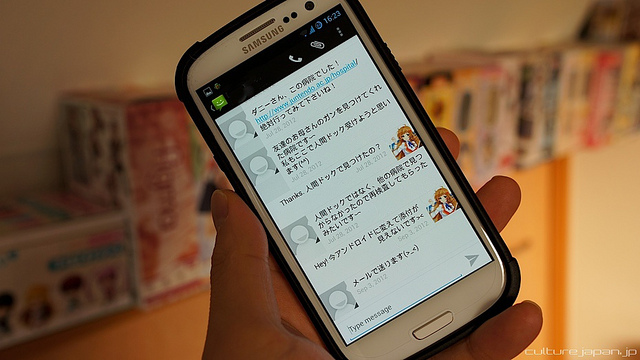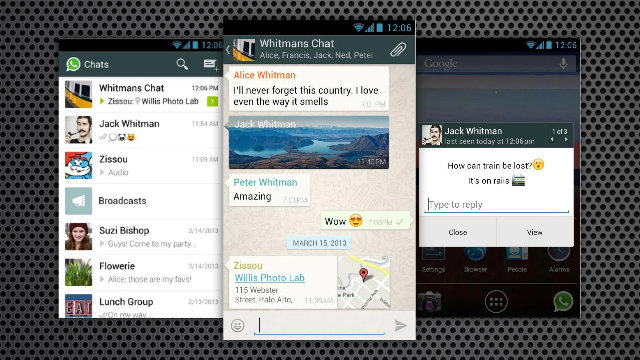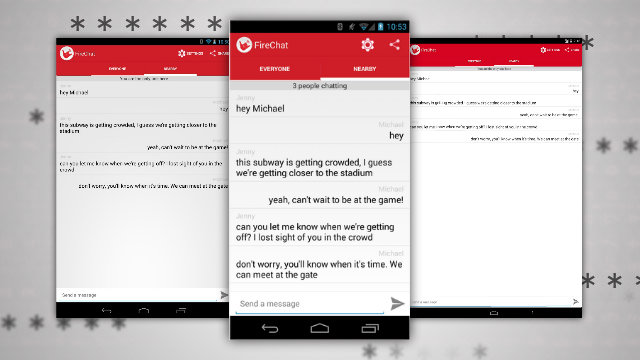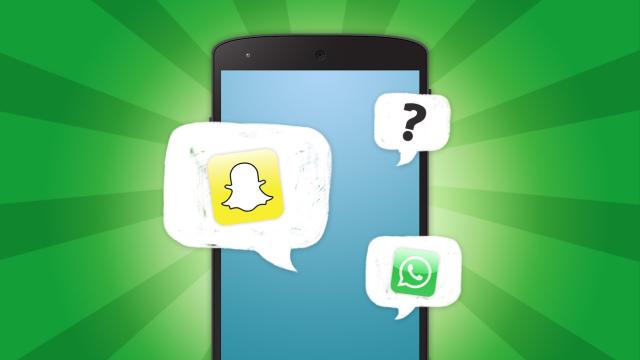Dear Lifehacker, I’ve been hearing a lot about different messaging apps these days, but I don’t understand why I should care. One search shows WhatsApp, Viber, iMessages, Snapchat, Kik, Facebook Messenger and dozens more. I already have text messaging. Why do I need these other apps? Sincerely, What’s App
Picture: Danny Choo/Flickr
Dear WA,
It seems like every day we’re reading about a new messaging app. It’s difficult to tell the difference between them, but they can be useful for specific situations. Let’s start by focusing in on what exactly the appeal of messaging apps is, then move on to picking the right one for your uses.
The Appeal of Messaging Apps

A messaging app is a pretty straightforward concept: they replace text messaging. Messaging apps aren’t just for teens, ne’er-do-wells and sexting. They’re especially useful for anyone who doesn’t want to pay for texting (or is communicating across country borders).
Chances are, if you have a smartphone, you’ve already encountered a messaging app. If you’re on Android, Google Hangouts is the default for messaging with other Android (and Google) users. If you’re on the iPhone, the Messages app has texting and iMessage (non-SMS messages between iOS devices) built-in. If you want a simple way to communicate with people between different devices, third-party messaging client make things easy. That’s where apps like WhatsApp or Snapchat comes in.
The appeal of these apps depends on the user. For some, it’s a way to get around SMS fees. This is especially the case if you’re communicating (or just travelling) internationally. For others, it’s a way to keep conversations private. Other apps let you set your status to tell friends you’re busy. All these make SMS more interesting by adding features, but which features you want depends on your needs.
For Replacing Text Messaging: WhatsApp

The popularity of messaging apps changes depending on the country, but WhatsApp is one of the most popular in the world. WhatsApp’s pitch is pretty simple: it looks like any old text messaging app, but you can create group chats, send photos, videos, voice messages and share your location using your data plan and not your SMS plan. WhatsApp is also available on iOS, Android, BlackBerry, Nokia S40, Symbian and Windows Phone, so all your friends can use it.
From just a feature stance, WhatsApp has pretty much everything you’ll ever need in a messaging client and more. It saves history, holds messages when you’re offline, allows for custom notification sounds, lets you set your availability, and more. It also integrates with your phone number, so you don’t need to worry about setting up a new account on a service you don’t want to use.
WhatsApp is popular for international messaging since you can do it over Wi-Fi without fees. It’s also handy when you have a group of friends who don’t use the same devices. As any Android user can attest, getting looped into an iMessage group message by a bunch of iPhone users is one of the most obnoxious things that can happen. WhatsApp makes sure everyone is on the same page. There’s no shortage of messaging apps out there, but WhatsApp has the benefit of being both popular (so its easier to get your friends to use it), and being feature-packed so everyone’s happy with the experience.
That said, if the recent Facebook acquisition of WhatsApp troubles you, you have a ton of alternatives to choose from. They all work essentially the same, except for a few features here and there. Chances are you’ll be fine with whichever alternative you and your friends choose.
Alternatives: Viber, Line, Facebook Messenger, Kakao, Kik Messenger, Google Hangouts.
For the Picture Lovers: Snapchat
Snapchat‘s main pitch is pretty simple: you can send self-destructing pictures and videos to each other. It’s no secret that Snapchat is often associated with sexting. While we don’t recommend using it to sext (if it can be seen, it can be copied), it’s actually become popular with the non-sexting crowd too.
From a purely theoretical standpoint, Snapchat is a good way to send pictures to a friend. For example, “how does this tie look?” are just as viable as “here I am in my underwear.” After all, not every single picture message you send someone needs to be saved forever.
Snapchat sticks to its guns and doesn’t do much more than pictures and video. That said, despite the fact that it’s not a secure way to sext, it is a good way to send pictures you don’t want cluttering up your storage space.
Alternatives: Instagram Direct, Clipchat.
For Local Chat: FireChat

FireChat is one of the more interesting messaging apps currently available because it uses a completely different kind of technology than the rest. Basically, FireChat lets you chat anonymously with local users over Wi-Fi or Bluetooth. You need to be within about 100m of each other and on the same local Wi-Fi network for it to work. Users can chain together to create a larger network if they’re all in the same area. It’s conceptually like peer-to-peer sharing. The tech’s a little complicated, but you can read more about how it works here.
FireChat doesn’t need an internet connection, but it does require that you’re close to each other. It’s also pretty simple, you can send text messages and pictures, but that’s about it. If you want to anonymously chat in a place that doesn’t have a strong internet connection or a local area, such as a trade show or sports game, FireChat makes it incredibly easy to do so.
The FireChat network is as big as the people using it, so it could be helpful during disasters where mobile service is down.
Alternatives: None (yet).
For the Productivity Geek: Emu
Emu is an iOS (Android coming soon) messaging app built for productivity geeks. It includes ways to schedule your day, share your location and has an internal reminders system.
Emu works somewhat like a “WhatsApp for grown-ups”. It has a lot of the same features (location sharing, voice messages, texting), but adds in organisation functions. For example, you can snooze messages for later and remind yourself to reply when you have the time. Emu also integrates with a calendar so you can book appointments right in the app. You can even book a table through OpenTable or grab movie showtimes.
Since Emu is iPhone-only at the moment, it’s a little difficult for everyone to use it, but the productivity integration makes it more useful for people who are trying to get business done through a messaging app.
Alternatives: Glassboard
For the Security Minded: Surespot
A lot of people are looking for a more secure way to communicate these days. You probably can’t keep your messages out of the NSA’s hands just by using another app, but you can keep your messages out of the hands of hackers. If you’re looking for a more secure, encrypted way to communicate, we like Surespot.
Surespot checks all the security boxes that it can while still being user-friendly and functional on a mobile device. It’s not associated with your phone number or email, it allows for multiple identities, it’s open source, and it includes 256 bit AES-GCM encryption. Basically, all that means you can create an anonymous profile and chat with people securely without too much hassle. As with anything, if someone really wanted to get into your messages, they could, but Surespot makes it pretty tough.
Other than encryption, Surespot’s a pretty simple messaging app. You can send pictures, text and audio in chats. You can also set how long an image or video is visible for, or revoke access to an image if you choose. They can always take a screenshot of course, but it’s better than nothing.
Alternatives: ChatSecure, Cryptocat (iOS), Wickr.
For People Interested in Dating: Tinder
Tinder is a dating app that searches for people near you and connects you to them if you’re both interested. You create a profile, then Tinder scans your local area looking for people with similar tastes. When you find someone you like, you mark their profile. If they like you back, you can start chatting and meet in person. Think of it like a high-tech version of passing a “Do You like me? Check this box” note in grade school.
Tinder is often billed as a “hookup” app, and that may be how its used most often, but the core of the service is technically about messaging. You send out your picture into the world, then if you somehow manage to find someone you like and who also likes you, you can chat. Once you’re in the actual messaging part, Tinder doesn’t go beyond sending basic text.
Tinder, and other apps like it, are essentially messaging apps, but their main goal is to connect you with people in real life. If that’s your thing, Tinder’s the most popular solution.
Alternatives: Let’s Date, Grouper, Hinge, Grindr.
The One Big Downside of Alternative Messaging Apps
Now, you’ve probably realised that there’s one big problem with these apps: like a social network, each app is only as useful as the people using it. None of these apps can communicate outside of the app or between different apps. So if you want to use WhatsApp but none of your friends are using it… you can’t really do much with it. You pretty much have to go with what your friends use (except for Tinder, maybe, unless you like awkward glances).
Text messaging is still the most universal way to message back and forth, which is probably why you haven’t felt the need to pick one of these up. Still, if your friends use one of them, that app might be worth picking up.
Messaging apps aren’t for everyone, and if you’re not an avid texter, your friends aren’t using any of these services, or you’re not worried about text messaging fees, none of the messaging apps are really useful. But if any of those things do spark your interest, they’re worth investing a little time in to pick one you like.
Cheers,
Lifehacker
Got your own question you want to put to Lifehacker? Send it using our [contact text=”contact form”].

Comments
7 responses to “Ask LH: What’s The Deal With All These Messaging Apps?”
I don’t see the point of chat apps, and why people use them. Everyone can SMS, and everyone has access to it instead of installing the app of choice.
Photos are different though.
I agree. Plus I have free unlimited SMS as part of my plan, so why not use it?
Personally I find them useful in two scenarios, group chats with people and staying in touch with people overseas. International texting be pricey 🙁
I’ve found apps which I can switch between mobile and desktop work well with work. Google hangouts is a good option, so is skype I’ve found.
If you have SMS and don’t see the point of the other apps, then there’s no reason to get them. Explore if you like, but they aren’t necessary.
Also from a technical standpoint, SMS is the most reliable.
The only messaging app I use is Hangouts. WhatsApp may be good to save money for international SMS, but thats something I very rarely do as most of my international contacts have this new cool thing called “e-mail”.
It wasn’t until I was having problems sending and receiving mms messages that I started searching for a replacement to my phone’s stock messaging app.I came across a messaging app called Textra, which turns the phone’s data connection on ,sends/receives mms, then turns data connection off, which if like me you keep data connection off most of the time,is great.